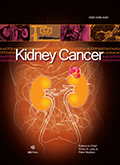Authors: Wilson, Lauren E. | Spees, Lisa | Pritchard, Jessica | Greiner, Melissa A. | Scales Jr, Charles D. | Baggett, Christopher D. | Kaye, Deborah | George, Daniel J. | Zhang, Tian | Wheeler, Stephanie B. | Dinan, Michaela A.
Article Type:
Research Article
Abstract:
BACKGROUND: Substantial racial and socioeconomic disparities in metastatic RCC (mRCC) have persisted following the introduction of targeted oral anticancer agents (OAAs). The relationship between patient characteristics and OAA access and costs that may underlie persistent disparities in mRCC outcomes have not been examined in a nationally representative patient population. METHODS: Retrospective SEER-Medicare analysis of patients diagnosed with mRCC between 2007–2015 over age 65 with Medicare part D prescription drug coverage. Associations between patient characteristics, OAA receipt, and associated costs were analyzed in the 12 months following mRCC diagnosis and adjusted to 2015 dollars. RESULTS: 2,792 patients
…met inclusion criteria, of which 32.4%received an OAA. Most patients received sunitinib (57%) or pazopanib (28%) as their first oral therapy. Receipt of OAA did not differ by race/ethnicity or socioeconomic indicators. Patients of advanced age (> 80 years), unmarried patients, and patients residing in the Southern US were less likely to receive OAAs. The mean inflation-adjusted 30-day cost to Medicare of a patient’s first OAA prescription nearly doubled from $3864 in 2007 to $7482 in 2015, while patient out-of-pocket cost decreased from $2409 to $1477. CONCLUSION: Race, ethnicity, and socioeconomic status were not associated with decreased OAA receipt in patients with mRCC; however, residing in the Southern United States was, as was marital status. Surprisingly, the cost to Medicare of an initial OAA prescription nearly doubled from 2007 to 2015, while patient out-of-pocket costs decreased substantially. Shifts in OAA costs may have significant economic implications in the era of personalized medicine.
Show more
Keywords: Renal cell carcinoma, oral anticancer agents, targeted therapy, chemotherapy, cost of care, health disparities
DOI: 10.3233/KCA-210119
Citation: Kidney Cancer,
vol. 5, no. 3, pp. 115-127, 2021





